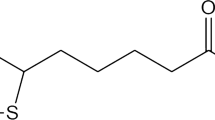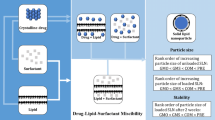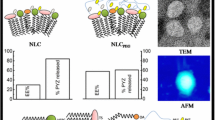Abstract
Purpose. Solid lipid nanoparticles (SLN) are comprised of a high-melting point triglyceride (TG) core with a phospholipid (PL) coating. This study has investigated the possible formation of multiple PL bilayers on the TG core of SLN's as a function of increasing the PL:TG molar ratio.
Methods. Trilaurin (TL) was used as the SLN core. Dipalmitoylphosphatidylcholine (DPPC) or a mixture of DPPC and dimyristoylphosphatidylglycerol (DMPG) were used to produce neutral and negatively charged SLN's. The volume of aqueous phase associated with the PL was determined using calcein and 6-carboxyfluorescein (6-CF) as hydrophilic markers incorporated during the preparation of the SLN's.
Results. The diameter of the SLN's decreased as the molar ratio of PL to TL was increased, until a PL:TL ratio of 0.15 was reached. After this point the diameter was not affected by further increases in the molar ratio. The experimental amount of PL required to prepare SLN's was significantly higher than the theoretical amount required to form a single monolayer on the surface. The aqueous volume associated with the PL was increased with increasing PL:TL molar ratios.
Conclusions. The results obtained suggest that the formation of multiple PL bilayers is probable in SLN's prepared with a high molar ratio of PL to TL. The volume of the aqueous phase between the PL-bilayers, estimated from the amount of the hydrosoluble markers trapped in this phase, provides an indication of the relative number of bilayers at different PL:TL ratios
Similar content being viewed by others
REFERENCES
B. Lundberg. Techniques for complexing pharmacological agents to lipoproteins and lipid microemulsions. In J. M. Shaw (ed.), Lipoproteins as Carrier of Pharmacological Agents, Marcel Dekker, New York, 1991, pp. 97–139.
F. Koosha, R. H. Müller, and S. S. Davis. Polyhydroxybutyrate as drug carrier. Critical reviews in therapeutic drug carrier systems 6:117–130 (1989).
Y. Ogawa. In vivo release profiles of leuprolide acetate from microcapsules with polylactic acid or copoly (lactic/glycolic) acids and in vivo degradation of these polymers. Chem. Pharm. Bull. 36:2576–2581, (1988).
A. Smith, and I. M. Hunneyball. Evaluation of poly (lactic acid) as biodegradable drug delivery system for parenteral administration. Int. J. Pharm. 30:215–220, (1986).
S. S. Davis, C. Washington, P. West, L. Illum, G. Liversidge, L. Sternsone, and R. Kirsh. Lipid emulsions as drug delivery systems. Ann. N.Y. Acad. Sci. 507:75–88 (1987).
S. Venkataram, W. M. Awni, K. Jordan, and Y. E. Rahman. Pharmacokinetics of two alternative dosage forms for cyclosporine: Liposomes and intralipid. J. Pharm. Sci. 79:216–219 (1990).
M. Y. Levy and S. Betina. Design and characterization of submicronized O/W emulsion of diazepam for parenteral use. Int. J. Pharm., 54:103–112 (1989).
R. J. Prankered, and V. I. Stella. The use of oil-in-water emulsions as a vehicle for parenteral drug administration. J. Parent. Sci. Technol. 44:139–149 (1990).
R. H. Müller, C. Schwarz, W. Mehnert, and J. S. Lucks. Production of solid lipid nanoparticles (SLN) for controlled drug delivery. Proc. Int. Symp. Controlled Release, Bioact. Mater. 20:480–481 (1993).
C. Schwarz, W. Mehnert, J. S. Lucks, and R. H. Müller. Solid lipid nanoparticles (SLN) for controlled drug delivery. I. Production, characterization and sterilization. J. Control. Rel. 30:83–96, (1994).
S. K. Huang, E. Mayhew, S. Gilani, D. D. Lasic, F. J. Martin, and D. Papahadjopoulos. Pharmacokinetics and therapeutics of sterically stabilized liposomes in mice bearing C-12 colon carcinoma. Cancer Research. 52:6774–6781 (1992).
A. Gabizon, R. Catane, B. Uziely, B. Kaufman, T. Safra, R. Cohen, F. Martin, A. Huang, and Y. Barenholz. Prolonged circulation time and enhanced accumulation in malignant exudates of doxorubicin encapsulated in polyethylene-glycol coated liposomes. Cancer Research. 54:987–992 (1994).
A. Tardieu, V. Luzzati, and F. C. Reman. Structure and polymorphism of the hydrocarbon chains of lipids: a study of lecithinwater phases. J. Mol. Biol., 75:711–733 (1973).
A. Watts, K. Harlos, and D. Marsh. Charge-induced tilt in orderedphase phosphatidylglycerol bilayers evidence from x-ray diffraction. Biochim. Biophys. Acta, 645:91–96 (1981).
L. J. Lis, M. McAlister, N. Fuller, R. P. Rand, and V. A. Parsegian. Interactions between neutral phospholipid bilayer membranes. Biophys. J., 37:657–665 (1982).
F. Gunston. The lipid Handbook, Chapman and Hall publisher, New York, 1986.
M. J. Hope, M. B. Bally, L. D. Mayer, A. S. Janoff, and P. R. Cullis. Generation of multilamellar and unilamellar phospholipid vesicles. Chem. Phys. Lipids. 40:89–107 (1986).
R. A. Parente, and B. R. Lentz. Phase behavior of large unilamellar vesicles composed of synthetic phospholids. Biochemistry, 23:2353–2362 (1984).
E. J. Findlay, and P. G. Barton. Phase behavior of synthetic phosphatidylglycerols and binary mixtures with phosphatidylcholines in the presence and absence of calcium ions. Biochemistry, 17:2400–2405 (1978).
H. Talsma, and D. J. A. Cromelin. Liposomes as drug delivery systems part I: preparation. Pharmaceutical Technology 16:96–106 (1992).
J. Li, and K. D. Caldwell. Structure studies of commercial fat emulsions used in parenteral nutrition. J. Pharm. Sci. 83:1586–1592 (1994).
H. Träuble, and H. Eibl. Electrostatic effects on lipid phase transitions: membrane structure and ionic environment. Proc. Natl. Acad. Sci. U.S.A. 71:214–219 (1974).
A. Watts, K. Harlos, W. Maschke, and D. Marsh. Control of the structure and fluidity of phosphatidylglycerol bilayers by pH titration. Biochim. Biophys. Acta, 510:63–74 (1978).
A. Watts, K. Harlos, W. Maschke and D. Marsh. Control of structure and fluidity of phosphatidylglycerol bilayers by pH titration. Biochim. Biophys. Acta, 510:63–74 (1978).
J. H. Senior, K. R. Trimble, and R. Maskiewicz. Interaction of positively-charged liposomes with blood: implications for their application in vivo. Biochim. Biophys. Acta 1070:173–179 (1991).
D. F. H. Wallach, D. M. Surgenor, J. Soderberg, and E. Delano. Preparation and properties of 3,6-Dihydroxy-2,4-bis-[N,N′-di(carboxymethyl)-aminomethyl] fluoran. Anal. Chem. 31:456–460 (1959).
N. C. Phillips, J. Stewart-Phillips, and P. Wang. Tumor cell binding and induction of endothelial cell tumoricidal activity in vitro by muramyl dipeptide is enhanced by liposomal encapsulation. J. Immunother. 15:185–193 (1994).
N. C. Phillips, L. Gagné, C. Tsoukas, and J. Dahman. Immunoliposome targeting to CD4+ leucocytes is dependent on immune status. J. Immunol. 152:185–193 (1994).
N. Oku, D. A. Kendall, and R. C. MacDonald. A simple procedure for the determination of the trapped volume of liposomes. Biochim. Biophys. Acta, 691:332–340 (1982).
E. Elbaz, A. Zeevi, S. Klang, and S. Benita. Positively charged submicron emulsion, a new type of colloidal drug carrier. Int. J. Pharm. 96:R1–R6 (1993).
Author information
Authors and Affiliations
Rights and permissions
About this article
Cite this article
Heiati, H., Phillips, N.C. & Tawashi, R. Evidence for Phospholipid Bilayer Formation in Solid Lipid Nanoparticles Formulated with Phospholipid and Triglyceride. Pharm Res 13, 1406–1410 (1996). https://doi.org/10.1023/A:1016090420759
Issue Date:
DOI: https://doi.org/10.1023/A:1016090420759




